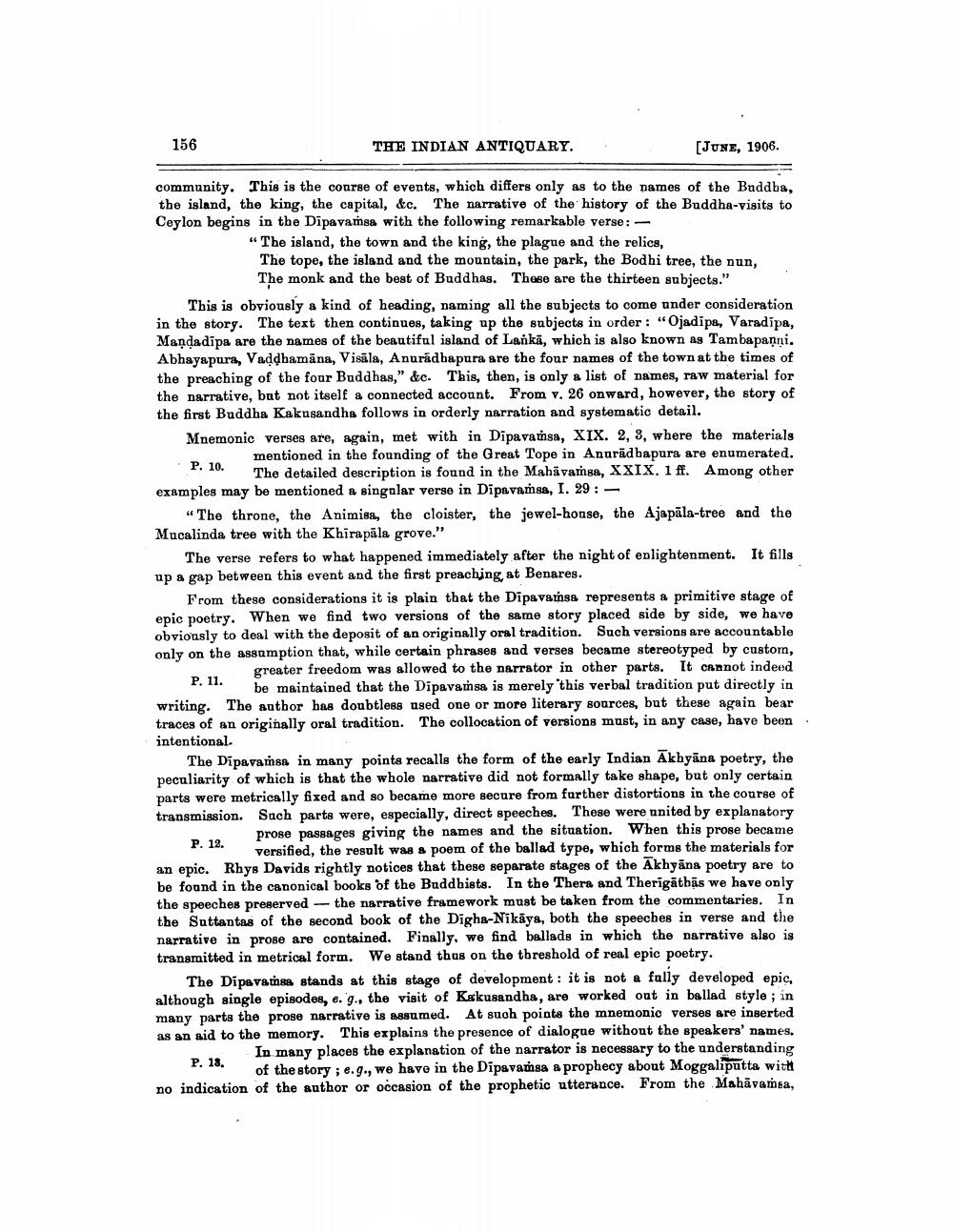________________
156
THE INDIAN ANTIQUARY.
[JUNE, 1906.
community. This is the course of events, which differs only as to the names of the Buddha, the island, the king, the capital, &c. The narrative of the history of the Buddha-visits to Ceylon begins in the Dipavamsa with the following remarkable verse: -
"The island, the town and the king, the plague and the relics,
The tope, the island and the mountain, the park, the Bodhi tree, the nun,
The monk and the best of Buddhas. These are the thirteen subjects." This is obviously a kind of heading, naming all the subjects to come under consideration in the story. The text then continues, taking up the subjects in order : "Ojadipa, Varadipa, Mandadipa are the names of the beautiful island of Lanka, which is also known as Tambapanni. Abhayapura, Vaddhamana, Visāla, Anuradhapura are the four names of the town at the times of the preaching of the four Buddhas," &c. This, then, is only a list of names, raw material for the narrative, but not itself a connected account. From v. 26 onward, however, the story of the first Buddha Kakusandha follows in orderly narration and systematic detail. Mnemonic verses are, again, met with in Dipavamsa, XIX. 2, 3, where the materials
mentioned in the founding of the Great Tope in Anuradhapura are enumerated. P. 10.
. 10. The detailed description is found in the Mahavamsa, XXIX. 1 ff. Among other examples may be mentioned a singular verse in Dipavamsa, I. 29:
“The throne, the Animisa, the cloister, the jewel-house, the Ajapāla-tree and the Mucalinda tree with the Khirapāla grove."
The verse refers to what happened immediately after the night of enlightenment. It fills up a gap between this event and the first preaching at Benares.
From these considerations it is plain that the Dipavass represents a primitive stage of epic poetry. When we find two versions of the same story placed side by side, we have obviously to deal with the deposit of an originally oral tradition. Such versions are accountable only on the assumption that, while certain phrases and verses became stereotyped by custom,
greater freedom was allowed to the narrator in other parts. It cannot indeed " be maintained that the Dipavamsa is merely this verbal tradition put directly in writing. The author has doubtless used one or more literary sources, but these again bear traces of an originally oral tradition. The collocation of versions must, in any case, have been intentional
The Dipavaṁsa in many points recalls the form of the early Indian Akhyāna poetry, the peculiarity of which is that the whole narrative did not formally take shape, but only certain parts were metrically fixed and so became more secure from farther distortions in the course of transmission. Sach parts were, especially, direct speeches. These were united by explanatory
prose passages giving the names and the situation. When this prose became
• versified, the result was a poem of the ballad type, which forms the materials for an epic. Rhys Davids rightly notices that these separate stages of the Akhyāna poetry are to be found in the canonical books of the Buddhists. In the Thera and Therigăthâs we have only the speeches preserved - the narrative framework must be taken from the commentaries. In the Suttantas of the second book of the Digha-Nikāya, both the speeches in verse and the narrative in prose are contained. Finally, we find ballads in which the narrative also is transmitted in metrical form. We stand thus on the threshold of real epic poetry.
The Dipavargs stands at this stage of development: it is not a fally developed epic. although single episodes, e. g., the visit of Kgkusandha, are worked out in ballad style ; in many parts the prose narrative is assumed. At such points the mnemonic verses are inserted as an aid to the memory. This explains the presence of dialogue without the speakers' names.
In many places the explanation of the narrator is necessary to the understanding F. 18. of the story ; e.g., we have in the Dipavamsa a prophecy about Moggaliputta with no indication of the author or occasion of the prophetic utterance. From the Mahāvamsa,




